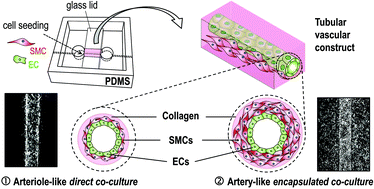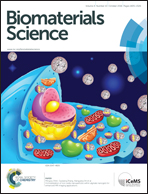Bottom-up fabrication of artery-mimicking tubular co-cultures in collagen-based microchannel scaffolds†
Abstract
We developed a robust bottom-up approach to construct open-ended, tubular co-culture constructs that simulate the human vascular morphology and microenvironment. By design, these three-dimensional artificial vessels mimic the basic architecture of an artery: a collagen-rich extracellular matrix (as the tunica externa), smooth muscle cells (SMCs) (as the tunica media), and an endothelial cell (EC) lining (as the tunica interna). A versatile needle-based fabrication technique was employed to achieve controllable arterial layouts within a PDMS-hosted collagen microchannel scaffold (330 ± 10 μm in diameter): (direct co-culture) a SMC/EC bilayer to follow the structure of an arteriole-like segment; and (encapsulated co-culture) a lateral SMC multilayer covered by an EC monolayer lining to simulate the architecture of a larger artery. Optical and fluorescence microscopy images clearly evidenced the progressive cell elongation and sprouting behavior of SMCs and ECs along the collagen gel contour and within the gel matrix under static co-culture conditions. The progressive cell growth patterns effectively led to the formation of a tubular co-culture with an internal endothelial lining expressing prominent CD31 (cluster of differentiation 31) intercellular junction markers. During a 4-day static maturation period, the artery constructs showed modest alteration in the luminal diameters (i.e. less than 10% changes from the initial measurements). This argues in favor of stable and predictable arterial architecture achieved via the proposed fabrication protocols. Both co-culture models showed a high glucose metabolic rate during the initial proliferation phase, followed by a temporary quiescent (and thus, mature) stage. These proof-of-concept models with a controllable architecture create an important foundation for advanced vessel manipulations such as the integration of relevant physiological functionality or remodeling into a vascular disease-mimicking tissue.



 Please wait while we load your content...
Please wait while we load your content...